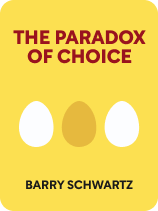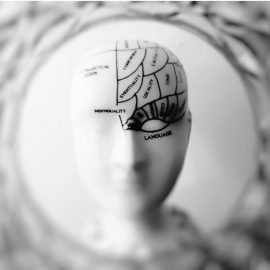

This article is an excerpt from the Shortform book guide to "The Paradox of Choice" by Barry Schwartz. Shortform has the world's best summaries and analyses of books you should be reading.
Like this article? Sign up for a free trial here .
What are the three different types of consumer choices? Why can having more shopping choices make you stressed out?
According to Barry Schwartz, the author of The Paradox of Choice, there are three types of shopping choices you likely encounter in your life: groceries, electronics, and entertainment. With so many products out there to choose from, Schwartz explains each type of choice and why you should or shouldn’t spend time on them.
Learn more about the three types of shopping choices below.
A Life of Choices
In his book The Paradox of Choice, Barry Schwartz writes that the choices we face in our lives have increased over time, and they continue to increase. They’ve also become more complex, and we often have little guidance or knowledge of how to make smart choices.
Schwartz attributes the expansion of choice to: 1) the incentives of market-based economies to provide as many options as possible for consumers, and 2) in the United States specifically, the nation’s core values of independence and freedom.
Schwartz explores and defines the major categories of choices—consumer choices, complex choices, and personal life choices—and the consequences of expanded choice in each of them:
- Consumer choices are choices about consumer or tangible goods, from potato chips to computers.
- Complex choices involve more complicated decisions about intangibles that have a greater impact on our lives than products. Examples are choosing which college to attend, which health insurance plan to choose, or which cell phone plan to purchase.
- Personal life choices are broad, long-term choices that don’t explicitly involve purchases, but instead incorporate how we want to experience our lives and present ourselves to the world. These typically involve choices about our personal relationships and our identities (religious, social, and so on).
This article will focus on the “consumer choices” category.
Consumer Choices
The first category is consumer choices, or shopping choices. These are small, routine choices about consumer products. Most people make multiple consumer choices on an average day.
Schwartz contends that these choices have expanded to the point that seemingly simple decisions require a lot of unnecessary thought and energy—for instance, if there are 30 brands of cookies to choose from at a supermarket, you must give more attention to deciding which cookie to buy.
One way to mitigate this stress in shopping choices is to identify the decisions that are worth your time and energy. To do this, Schwartz distinguishes between “durable” and “nondurable” consumer goods: Durable goods are those that last a long time, like electronics or appliances, and nondurable goods are used quickly, like groceries.
People typically spend more money, time, and energy to choose among durable goods than nondurable ones, because you’ll use these goods for a long time, the lengthier decision-making process is worth the effort. In contrast, by spending too much time making choices among nondurable goods, we use up energy we should spend on choosing durable goods.
(Shortform note: All durable and nondurable goods are tangible, meaning they’re physical objects you can use. In contrast, services, such as restaurant service or exercise classes, are intangible. Broader life choices, like marriage or religion, can’t accurately be described as either goods or services.)
With durable and nondurable goods in mind, Schwartz lists the different kinds of shopping choices people frequently make.
Groceries
Schwartz paints a picture of the vast array of choices a shopper faces at a grocery store. He writes that he counted the number of brands he noticed in a store for various products. The results? Dozens of brands and varieties of just about everything: crackers, juices, chips, suntan lotion, lipstick.
Different brands and varieties, of course, aren’t all that different. One kind of potato chip might be extra salty, one might be low-sodium, and another might have ridges, but they’re all similar products.
This overwhelming variety often leads shoppers to buy only what they’re familiar with. Since it would take a long time to compare many products to each other, buying something you’ve purchased before and found satisfactory is the easiest way to go. To support his point, Schwartz cites a statistic indicating that the average shopper doesn’t notice 75% of the products in their supermarket, instead sticking with the products they already buy.
(Shortform note: Schwartz’s assertion that grocery stores carry an overwhelming amount of products is reflected in current data: According to the food industry association FMI, the number of items an average supermarket carries is 31,119. While Schwartz focuses on large supermarkets, bear in mind that there’s a wide array of grocery stores, including small, local markets; farmers markets; dollar stores; wholesale clubs; high-end grocers, and so on. So before deciding what items to buy, you must first choose among a variety of grocery store types.)
It might be overwhelming, but since the items in a grocery store are nondurable goods that don’t last, Schwartz says your decisions don’t matter much in the long term. If you don’t like one brand of cereal, you can get another without much of a problem.
Electronics
The process of shopping for electronics in a store is similar to grocery shopping, yet since electronics are durable goods, the stakes are higher. Electronics are meant to last a long time and accordingly cost more, so Schwartz says that it’s more important to think about your purchase.
Schwartz found almost as much variety in an electronics store as in the grocery store. Since electronics are durable goods, making a decision will likely be more challenging than choosing groceries. Additionally, most people don’t buy printers or televisions often, so it’s harder to default to a familiar brand.
| Since the publication of The Paradox of Choice in 2004, the durability of many electronic devices has declined. Widely used appliances like cell phones and laptops are no longer built to last; instead, they typically lose their functionality after a couple of years, so consumers are incentivized to purchase new ones. That said, electronics remain more durable than products like groceries and clothing. Additionally, the variety of electronic products has grown, with multitudes of laptops, smartphones, tablets, and other gadgets available. As of 2015, for example, over 24,000 styles of Android smartphones were available, a number that has presumably grown since then. |
Entertainment
Just about anything you could possibly want to watch or listen to is now available with the click of a button. For this reason, Schwartz says that even choosing entertainment for relaxation can cause indecision and stress.
Entertainment is generally a durable good. Whether you buy a collection of albums, subscribe to a new streaming service, or purchase a new cable plan, your entertainment choices typically last for a sustained period of time.
(Shortform note: When Schwartz discusses entertainment, he mainly refers to it as a durable good. However, there are many instances where an entertainment-based purchase would be considered nondurable—buying a ticket for a concert or a movie, for example. One could also argue that cable and streaming packages would more accurately be categorized as services than goods, even though the devices needed to access them are typically durable goods. In any case, the proliferation of entertainment options carries with it the difficulties of expanded choice, no matter how we categorize them.)
The number of entertainment options we can enjoy from home increases every day. When Schwartz wrote The Paradox of Choice in 2004, cable television provided viewers with hundreds of channels, and TiVo allowed viewers to record numerous programs to watch whenever they wanted.
(Shortform note: Our options have grown exponentially since then. Cable and TiVo are still available, but subscription streaming services have become increasingly popular. As of 2021, there are over 200 streaming services available for a subscription, from the uber-popular Netflix to niche services like Shudder, a service for devoted horror fans. These streaming services often have hundreds of shows and films to choose from. Combine streaming services with cable, network television, on-demand offerings, and physical media like Blu-rays, and one can easily see how the vast array of entertainment options can be overwhelming.)
Schwartz theorizes that, someday soon, there will be little-to-no water cooler conversation about the latest hit TV show, because no two people will be watching the same shows.
(Shortform note: With the plethora of streaming options now available, Schwartz’s prediction has largely come true. While some television shows, such as Game of Thrones, have generated widespread public discussion, the general entertainment landscape is still more fragmented and individualized than in the past.)
| Online Shopping and Consumer Choices In the years since The Paradox of Choice was published, online shopping has further increased the number of consumer options and has made it easier to access them, particularly with the rise of Amazon Prime and two-day shipping. Amazon has become by far the most dominant online retailer, and their prioritization of speedy shipping has created new consumer expectations for convenience. As of 2020, there were approximately 200 million Amazon Prime members worldwide, with more than half concentrated in the United States. Amazon allows customers to set some purchases to recur automatically, potentially lessening the choices we make. However, despite the new ability to automate some choices, online shopping also has the potential to add to our mental loads. For example, its convenience makes it easier to spend much more time shopping than before the rise of e-commerce. Plus, there are many more choices available online than in brick-and-mortar stores. Ultimately, we can easily get carried away with searching for the best products, comparing items to one another, and reading dozens of reviews. |

———End of Preview———
Like what you just read? Read the rest of the world's best book summary and analysis of Barry Schwartz's "The Paradox of Choice" at Shortform .
Here's what you'll find in our full The Paradox of Choice summary :
- Why the more choices we have, the more stressed and indecisive we feel
- How to better navigate our choices, from groceries to health insurance
- Whether it's better to seek the best or accept "good enough"






